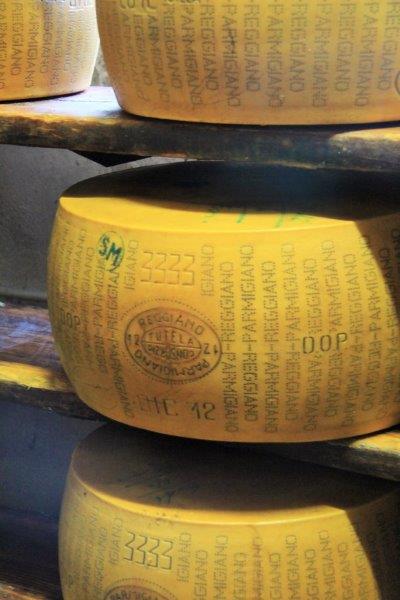 Parmigiano Reggiano cheese, often referred to as the “king of cheese” has been produced using the same recipe for 900 years! And today we are going to a local dairy to see how it is made. So exciting!
Parmigiano Reggiano cheese, often referred to as the “king of cheese” has been produced using the same recipe for 900 years! And today we are going to a local dairy to see how it is made. So exciting!
We are off through the rolling hills and countryside of Emilia Romagna to Caseificio San Pier Damiami in San Prospero. Arriving at 9 am for the morning cheese production, the tour lasts two hours and you see the cheese production process as it happens every morning 7 days a week. It was fantastic!
This is a family run operation, and has been for several generations. This morning Mom takes us on the tour while Dad, daughter and her husband make the cheese.
What is Parmigiano Reggiano ?
To be labelled as Parmigiano Reggiano cheese, which is a DOP designation (protected designation of origin), the cheese must meet the following strict guidelines governing production:
- Made in the Emilia Romagna region of Italy, in the following areas: Parma, Reggio Emilia, Modena, Mantova and Bologna.
- Have only milk, rennet, and salt as ingredients- that’s it!
- Milk must be from grass fed cows in the area of origin.
- Feed for the cows must also be from region. (No animal products used as feed for the cows!)
- Processed into minimum 30 kilo wheels.
- Processing and maturation of the cheese must also take place in the region.
- Must be matured for a minimum of 12 months.
- Inspected at completion of maturation and certified by the consortium.
Making Parmigiano Reggiano
The production of cheese is a relatively simple process (says those of us that just watched!). To make Parmigiano Reggiano :
- Raw milk from the evening milking is placed in large copper vats. It is left overnight and in the morning the milk from the morning milking is added.
- Rennet, from the previous day’s whey, is added. The rennet turns the milk to curds.
- The curds are broken up using a large spatula shaped like a bee hive, called a “spino.”
- Then the cheese is cooked.
- After sedimentation, it is shaped into wheels weighing a minimum of 30 kilos, many are closer to 40 kilos. The remaining whey is sold to another cheese producer to make ricotta cheese. (Nothing is wasted from the process.)
- The drying and draining of the cheese.
- The wheel is placed into plastic cases for settling.
This process is repeated each day, and is the process we observed as part of the tour. The team, which is only 3 people worked hard all morning. They worked well together and to the visitor it appeared a well run operation. At the completion of production, the cheese wheel is moved to the Curing/Brining Room.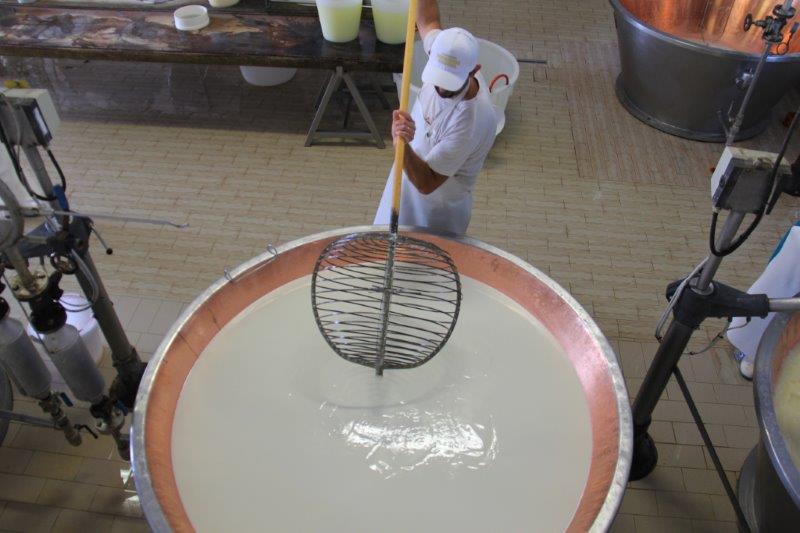
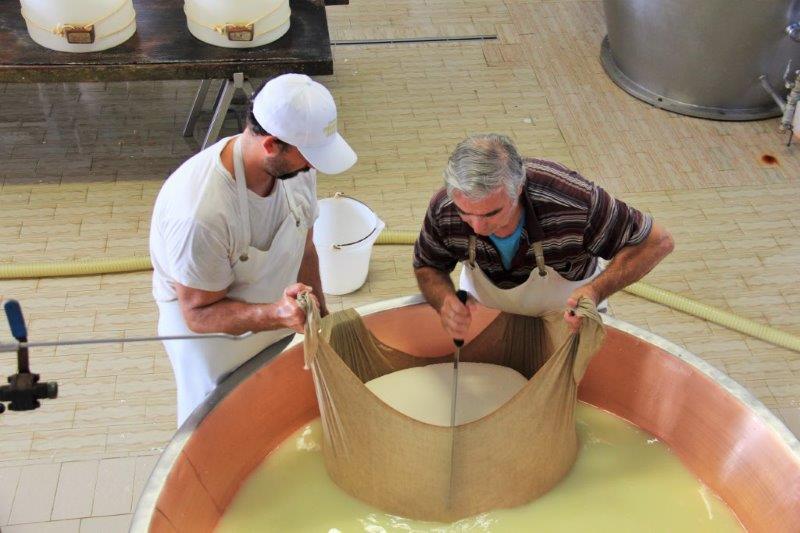
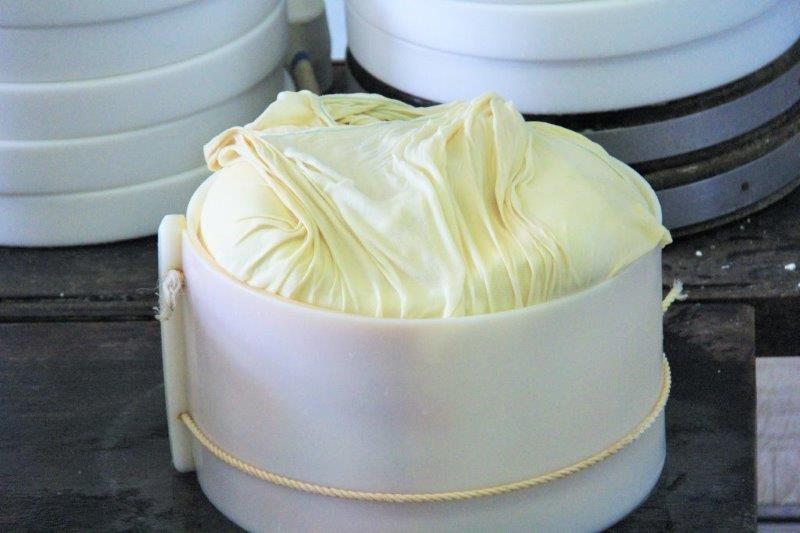
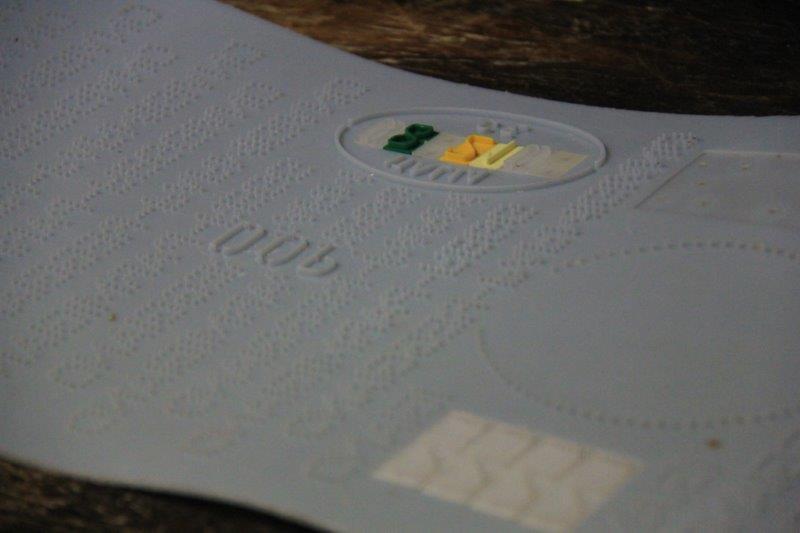
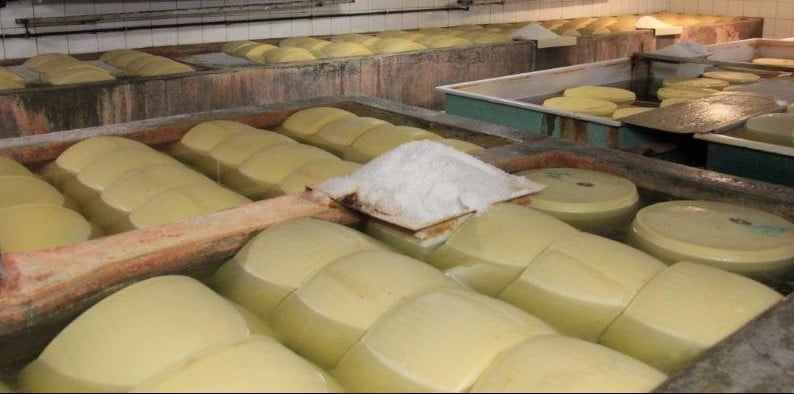
Curing/Brining Parmigiano Reggiano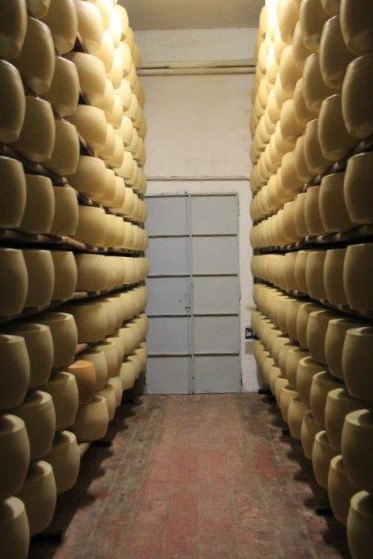
This is where the third ingredient salt is added.
- Each cheese is labelled as to the dairy and the date (month/year produced) when it is transferred to a stainless steel mould wrapped in a plastic label, which looks a bit like braile. The label includes “Parmigiano Reggiano,“ the dairy, date made and this becomes the markings on the outside of the wheel which continues to darken as the cheese matures.
- The wheel is immersed in brine for several days.
When the brining has been completed the cheese wheels are moved to the maturation room.
Parmigiano Reggiano Maturation Room
The smell when you walk into this room. The view! If only there was smell-o-vision on the computer so we could share! Seriously if you like cheese, the maturation room is incredible.
In this room the cheese is matured for at least 12 months (in the region). The room is maintained at 16 degrees C and 80+% humidity while the cheese matures. Floor to ceiling this room is wall to wall Parmigiano Reggiano!
Inspection and Certification
After 12 months in the maturation room, the cheese is ready for inspection by the consortium. Each individual wheel is checked and tested.
It is an 8 point test including a sound test. Using a cheese mallet, the wheel is tapped and it must make the required sound. A screw needle or dowel is used to drill into the wheel and remove a small sample. The tester can check the cheese visually and by the aroma. If it passes- it is branded and becomes an official product (DOP).
If it fails, the rind with the Parmigiano Reggiano labeling must be removed and it can be sold as mezzano or mezzo- seconds. The taste is still largely the same but it did not settle properly often having air bubbles inside the wheel which affects the noise.
Some wheels are aged to be 12+ months, after 24 months the taste intensifies, crystals of an amino acid called tyrosine develop (indicating to the consumer it is a mature Parmigiano Reggiano), after 36 months the taste is quite strong and the cheese is sold as “strevicchio” or strong.
In the Emilia Remagna area 24 month old Parmigiano Reggiano sells between 14-19 euros a kilo. (A lot less than we pay at home!)
Differences to Grana Padano
A similar cheese to Parmigiano Reggiano, Grana Padano is widely available both in Italy and probably where you live. Grana Padano is another DOP product from Northern Italy, but its production is slightly different.
- Grana Padano is made only with skimmed milk, Parmigiano Reggiano uses both whole and skim milk.
- Cows for Parmigiano Reggiano have greater dietary restrictions than those used for Grana Padano.
- The region for Grana Padano production (the protected area of origin) is about double the area for Parmigiano Reggiano
Due to the greater volume of production and less restrictions, Grana Padano cheese is usually less expensive than Parmigiano Reggiano.
It is milder in taste, but has many of the same uses as Parmigiano Reggiano.
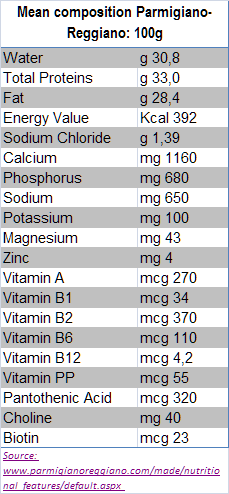 Nutritional Information
Nutritional Information
Some interesting Nutritional Information
- Parmigiano Reggiano is only 30% water, 70% is nutrients
- Parmigiano Reggiano is very rich in calcium and is a good source of phosphorous.
- Parmigiano Reggiano is lactose free!
Arranging your Visit
Personally, I don’t find Italy to be the easiest place to travel as an independent traveler (but that could be the subject of a whole other post!) and it took a bit of persistence to find and arrange a tour of a Parmigiano Reggiano dairy. (Most want you to arrive in a group or have very limiting opening times.)
I can recommend San Pier Damiami Dairy. The family was very welcoming, the tour was well organized, it was informative, included a tasting and demonstrated the entire process. (At the time of our visit it cost €5.) You can contact them via the website to arrange your visit When you inquire let them know the number of people, language, and when you will be in the area, it will save you going back and forth via email.
info@caseificiosanpierdamiani.it, +39 0521 645181
Parmigiano Reggiano Museum
But it has very limited (but not unusual, and totally infuriating) opening times/conditions:
From March 1 to 8 December
Saturday, Sunday and holidays: 10.00 – 13.00, 15.00 – 18:00
From Monday to Friday, only by booking for your group of 10 or more
So if you happen to be in the area on a weekend,
The Museum of Parmigiano Reggiano
c/o Corte Castellazzi,
Via Volta, 5
Soragna (Parma)
Links
- There is a series of videos about the making of Parmigiano Reggiano available online.
- And an online course about tasting Parmigiano Reggiano
If you enjoyed this post, you might like:
The Emilia Romagna Region in Northern Italy: Home to Great Food
Herb Crumbed Fish Recipe inspired by the Venice Fish Market
Veneto beyond Venice
Italian Wine, Grappa and Tiramisu: Unwinding in Veneto
A Perfect Day in Venice
And to help you plan your trip to Italy:
Traveling in Italy: What you Need to Know
To further explore the food and culture of Northern Italy:
Modena Market Porcini Mushroom Risotto with Truffle Oil
Traditional Balsamic Vinegar of Modena: more expensive than fine wine?
Tortellini with Sage and Butter Sauce
Italian Antipasto Platter
Penne Puttanesca an Italian Classic
Baked Stuffed Zucchini Flowers or Squash Blossoms
Italian Dinner Party


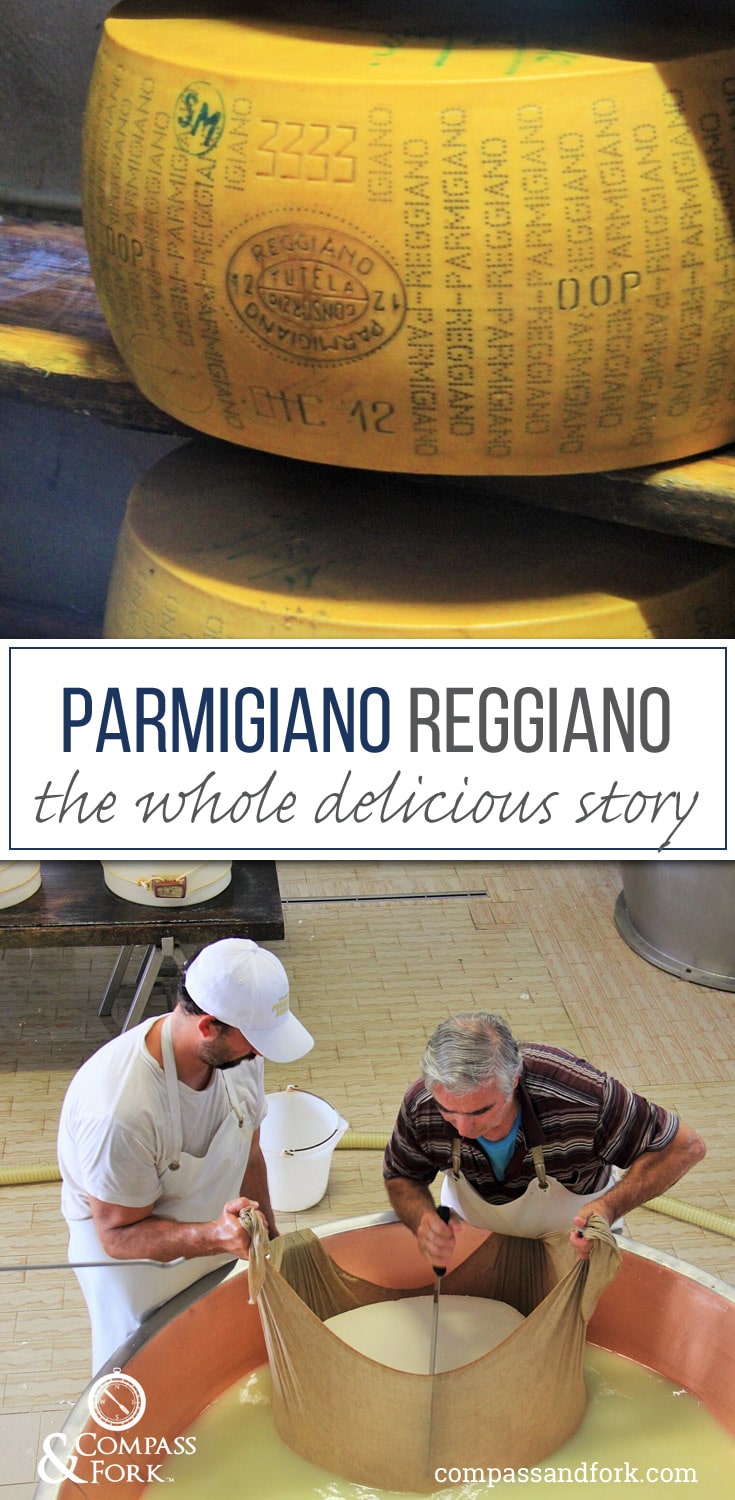
Debbie @ Traveling Well For Less
Great fact – hadn’t realized Parmigiano Reggiano cheese (like champagne) was protected. Some serious muscles on the guy working the cheese vat. Thanks for the link on how to book the tour, have added it my bookmarks.
Editor
Debbie, I hope you enjoy it if you get a chance to visit. We certainly did. Seeing that cheese room (and smelling it) is just incredible!
Leisel S
This is perfection! My family uses this cheese in our pizzeria and it’s awesome to see what exactly goes into it. No wonder it’s so good.
Editor
I agree. It is a common cheese but until we visited I had no idea.
Leilani
One of the most fascinating programs on food I ever watched was the Thirsty Traveller’s episode on Parmegiano Reggiano. It blew my mind the work that went into this fabulous cheese. Thanks for all the info again.
Editor
You are right about the fascination around Parmigiano Reggiano. We really enjoyed our tour and the tasting as well. Thanks for the information on the Thirsty Traveller, we will look out for it. Cheers….Mark
Sheila @ BrainPowerBoy
Very interesting. We went to a cheese factory a couple of years ago and go to see the whole process. We also got to try a few samples afterwards. You have wonderful pictures of the tour.
Editor
Thanks for your comments Sheila. We have been on a few cheese tours and loved them all. It was great to see how the family all worked together each and every day. Cheers….Mark